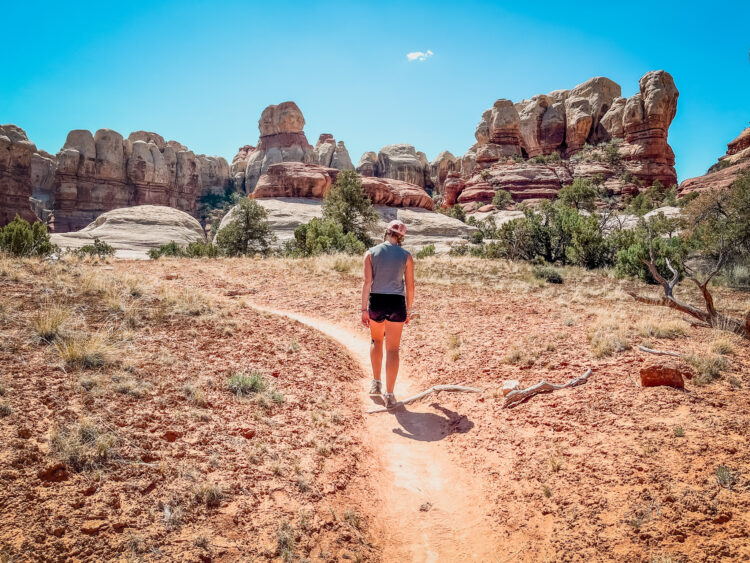Are you gearing up for some winter hiking and trying to decide on crampons vs microspikes vs snowshoes? Perhaps you wonder what’s the difference between crampons and microspikes. Or whether crampons or snowshoes are better for winter hiking? Below you can find a quick description of the differences between microspikes, snowshoes, and crampons, suggestions on when to wear what, as well as some suggestions of our favorite brands and places to buy each of these.
We love to winter hike and have used all these tools in different conditions over the year. Whether you are looking for something to tackle a local walking trail with your dog, or are getting ready to hike a snow-covered peak, this guide will help you find the best tool for your next adventure.
This post may contain affiliate links from Amazon or other affiliate programs. This means I may get a small compensation when you purchase something through this site.
A Quick Look at Winter Hiking Footwear for Snow and Ice
Crampons, microspikes, and snowshoes are all great tools for winter hiking and each have a unique purpose. Since they serve different purposes, you may find that you need more than one tool to aid in your next winter adventure. Here is a quick rundown of the different options:
Crampons
Crampons are large, firm spikes that attach to your hiking boots. They come with many different strap options, but are typically stiff with 5-12 sharp points, mostly on the toe. These points dig into ice and are best for climbing on vertical and thick ice. Crampons were originally designed for ice climbing and mountaineering, but you can also purchase crampons that can be used on smaller hikes with elevation gain.
Crampon Design: Stiff or firm frame with multiple large spikes on the bottom, mostly on the toe
Preferred Use: best for steep slopes with thick ice or mountaineering
Not Best For: Overkill on flat or low ice areas and difficult to use with wet, clumping snow
Microspikes
Microspikes range from smaller crampon styles to bands of metal that run underneath your boot or even sneakers to give you added traction on ice. Microspikes are best for icy trails with moderate to low grades. You can also use microspikes to help with shoveling your driveway, walking your dog, running, or anywhere where a little traction would help on ice or well-packed snow. Microspikes are not best for situations that involve very steep climbing, large sheets of ice, or clumpy snow that builds up on the bottom of the microspikes.
Design: Small spikes or metal that attach to the bottom of a shoe or boot. Straps can be stretchy rubber or webbing.
Preferred Use: Microspikes are best used for aiding traction on moderate to low-grade hikes and walks. Use microspikes anytime added traction is helpful on ice or well-packed snow such as walking, hiking, or running.
Not Best For: Mountaineering or heavy snow usage or steep hiking
See more about choosing the best set of microspikes: The 7 Best Microspikes for Hiking, Walking, and Running

Snowshoes
Snowshoes come in a range of designs and are meant to keep the walker on top of the snow by creating a bigger footprint area. Snowshoes attach directly to your boot with straps. Many snowshoes also have crampons on the bottom to give them additional traction, but are primarily meant for hiking in lots of snow. Snowshoes are best for hiking on fresh snow that is at least 5 inches deep and are excellent at breaking trails after heavy snow.
Design: Attached directly to your boot with straps, snowshoes create a larger footprint and are best for hiking in deep snow.
Preferred Use: Breaking trail after heavy snow, winter hiking in fresh snow.
Not Best For: light snowfall, hiking with just ice, extreme mountaineering.
Comparing Crampons vs Microspikes vs Snowshoes
So how do you choose which is the best winter footwear to choose when heading out on a hike? The information below is written based on years of winter hiking to help you select the best option for you. If you scroll down further, you can also find links or ideas for purchasing microspikes, snowshoes, and crampons. If you are reading this and trying to decide whether to purchase crampons vs microspikes, it may be worth either starting with microspikes or purchasing a pair of each since they have different usage.

Crampons vs Microspikes
The main difference when comparing crampons vs microspikes is the size of the spike on the bottom of the foot. Crampons have a large spike that is better for steep climbing on thicker ice such as when you’re ice climbing or mountaineering. Microspikes have either smaller spikes or metal bands across the bottom and are better for lighter hiking on flat to moderate slopes with ice and packed snow. Both crampons and microspikes attach directly to the bottom of a shoe or boot.
Unless you are embarking on a large hike with heavy sheets of steep ice, you are better off with a pair of hiking microspikes. We hike extensively in the winter in New Hampshire and almost exclusively use microspikes. Since there is a wide range of microspikes, select microspikes with small spikes for hiking or walking where there is a gain in elevation. Choose YakTrax or microspikes with very small spikes for winter walking or running.
Microspikes vs Snowshoes
Microspikes and snowshoes can both be used in the winter for hiking, but microspikes are best for low snow conditions when you are more likely to encounter ice or hard-packed snow. Snowshoes often have crampons on the bottom but are designed to keep the hiker above the snow instead of sinking deep into the snow. Unlike comparing crampons vs microspikes that can sometimes be used interchangeably in slightly different conditions, the difference between snowshoes and microspikes is much clearer.
Even when we head off on a hike with snowshoes, we often bring microspikes, as you might find the conditions change as you gain elevation, or you may find a well-packed trail that is better for microspikes than snowshoes. Microspikes are relatively light and easy to carry on any winter hike.
Since microspikes are relatively inexpensive and light, instead of comparing crampons vs microspikes, you can also carry a pair of each.
Crampons vs Snowshoes
Both crampons and snowshoes are designed for winter travel in the mountains. Since most snowshoes have some form of crampon on the bottom, you can easily use snowshoes for winter hiking up a mountain where you might also use crampons. Snowshoes are best for deep snow when you want to stay above the level of the snow such as when you are breaking trail On the other hand, crampons are best for hiking in icy conditions and may get snow clumping on the spikes when snow is wet.
We’ve done plenty of winter hikes where we pack snowshoes, only to find the trail already well broken. In this situation we strap the snowshoes on our pack and hike in just our boots. Often as we make the way up the trail and the snow gets deeper and you do start to posthole (where your foot goes down through the deep snow) we will put on your snowshoes back on our feet.. If you are looking for a good pair of snowshoes, I have used my Tubbs for over 20 years. This pair of TUBBS is very similar – and you can find more suggestions below.
The Best Microspikes for Hiking
If you are winter hiking, or even just living where you get lots of snow and ice, a pair of microspikes is a must-have item. We use our microspikes all the time, and carry them on every winter hike. You can see a full post on our favorite microspikes, but below are three excellent options.
When you are purchasing a pair of microspikes, there are several elements to consider to make sure you get the right size and usage. Here at a few things to consider:
Spike Length: The length of the spike on the bottom of the microspikes will impact how well the microspikes dig into the ice. If you will be hiking in steep and icy conditions, get larger spikes for better traction. Some microspikes don’t actually have spikes at all, but bands of metal. These are best for flat tracks where you just need a little extra traction, but aren’t recommended for winter hiking with elevation.
Durability: You want a pair of microspikes that will last for years. Most microspikes attach to the boot with rubber straps that are rated down to a certain temperature. Look for sturdy straps that attach securely to the metal portion of the microspikes.
Ease of Use: We often wear and remove our microspikes multiple times during a hike. It’s important that your microspikes are easy to get on and off. I prefer microspikes with just the stretchy rubber strap that can be put on without taking off my gloves.
Weight and Packability: Choose a pair of microspikes that are easy to carry and lightweight.
Kahtoola MICROspikes
These are our favorite all-around microspikes, they check all the boxes, and we consider them the best microspikes for hiking. There are sturdy yet lightweight with a good all-around spike length for winter hiking on ice and around the home walks.
They are very easy to get on and off and have stood up for all of our winter adventures
Yaktrax Diamond Grip All-Surface Traction Cleats
Unlike the microspikes above, Yaktrax don’t have spikes on the bottom. If you will be doing most of your winter hiking on low slope surfaces, these are an excellent choice. You won’t have quite the traction on hard and steep ice.
These are also easy to get on and off and easy to carry in your pack.
LINXGR 11-Spikes Kids Crampons Ice Cleats
Since we almost always hike as a family, it’s important that our kids have microspikes for our winter adventures. These are high-quality microspikes for the price. For adults – I always recommend getting gear that lasts for years. For kids, who may outgrow the gear in a few years, you want gear that will last for a few years.
The Best Crampons for Hiking
If you are looking for some more serious footwear for winter hiking and mountaineering, you will want crampons with a larger set of spikes. Select crampons that are sturdy with an adjustable strap. Crampons are almost always more expensive than microspikes. We only use our crampons occasionally, but we’ve had the same pair for years.
BLACK DIAMOND Serac Crampon
These are an excellent pair of crampons that will last for years. The strapping is easy to use and sturdy. The sharp spikes on the front of these crampons are ideal for serious winter hiking on slick and steep ice.
The Best Snowshoes for Hiking
The final option when comparing microspikes vs crampons vs snowshoes is getting a good pair of snowshoes. There are many different styles and sizes of snowshoes available at a range of costs. The most important elements to look for when selecting snowshoes are price, durability, size, and straps.
Price: Snowshoes are typically more expensive than microspikes so it is important to get a pair that will last and you want to keep. When buying snowshoes you get what you pay for, so you are best off spending a bit more on a quality pair of shoes.
Durability: Durability is important and having a broken snowshoe out on the trail is no fun.
Size: Size is very important when selecting snowshoes. If you choose snowshoes that are too small, they won’t keep you on top of the snow. If you choose snowshoes that are too big, you will constantly be tripping over them.
Straps: You want straps for your snowshoes that will stay on, but also be easy to take on and off.
Elements: Snowshoes are coming in an increasing variety of styles. The main element to look for is a sleek design and if you will be using them for any type of vertical hiking, attached crampons on the toe portion of the snowshoes.
Tubbs Mountaineer Backcountry Snowshoes
We’ve always liked Tubbs snowshoes, and this is an excellent pair if you are looking to do some hiking. They are high quality with excellent straps and crampons.
If you are looking for more options for Tubbs Snowshoes, check out EMS.
Final Thoughts on Crampons vs Microspikes vs Snowshoes
Hopefully, this has answered your questions about choosing the right winter footwear for traction on ice and snow. While microspikes, crampons, and snowshoes all have different uses, you may need all 3 if you plan to spend a lot of time outside in the winter. If you are still wavering, start with a pair of microspikes since they are the most versatile and are the least expensive. From here, consider a pair of snowshoes or crampons based on what type of activities you are planning.
Hope you enjoy your next winter adventure!
If you’re looking for other suggestions on outdoor gear, check out our gear pages.











